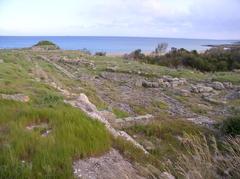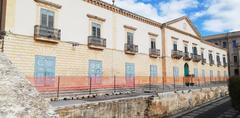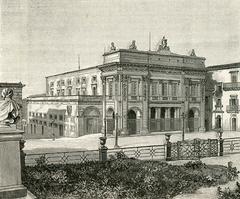Netum Ancient Noto: Visiting Hours, Tickets, and Historical Sites in Italy
Date: 15/06/2025
Introduction: Exploring the Legacy of Netum and Noto
Nestled in the sun-drenched southeast of Sicily, Noto captivates visitors with a compelling blend of ancient ruins, Baroque splendor, and vibrant cultural traditions. Once the thriving city of Netum, inhabited by the Siculi before flourishing under Roman, Byzantine, Arab, Norman, and Aragonese rule, this area is an extraordinary testament to Mediterranean history. The evocative ruins of Noto Antica—fortified walls, the Gate of the Mountain, ancient tombs, and the Royal Castle—bear silent witness to centuries of strategic and cultural significance (Britannica; Wonders of Sicily).
The catastrophic earthquake of 1693 reshaped the region, destroying the original city and prompting the construction of a new Baroque Noto on a nearby site. This urban renaissance, led by architects like Rosario Gagliardi and Vincenzo Sinatra, resulted in the harmonious, honey-hued city now celebrated as a UNESCO World Heritage Site (Britannica; Dining Traveler). Today, visitors can explore both the archaeological park of Noto Antica and the architectural marvels of modern Noto, immersing themselves in Sicily’s layered past.
This comprehensive guide offers detailed information on visiting hours, ticketing, accessibility, and travel strategies, ensuring a seamless and enriching experience for every traveler.
Table of Contents
- Ancient Origins: Netum and Early Settlements
- The Catastrophic Earthquake of 1693
- Baroque Noto: Urban Planning and Reconstruction
- Architectural and Cultural Highlights
- Noto’s Role in Sicilian and Italian History
- Preservation, Archaeology, and Modern Rediscovery
- Visitor Insights: Exploring Noto’s Historical Layers
- Noto and the Val di Noto
- Exploring Noto Antica: Hours, Tickets, and Tips
- Ancient Netum: Archaeological Features
- Modern Noto: Baroque Splendor and UNESCO Heritage
- Cultural and Natural Attractions
- Experiential Highlights
- Practical Visitor Tips
- Frequently Asked Questions (FAQ)
- Getting to Noto: Transport and Access
- When to Visit: Weather, Festivals, and Crowds
- Navigating Noto: Getting Around
- Accommodation and Dining
- Essential Sights: Tickets and Opening Hours
- Practicalities: Money, Safety, Language, Dress Code
- Accessibility and Family Travel
- Day Trips and Surroundings
- Budgeting and Costs
- Visual Resources
- Final Thoughts and Call to Action
Ancient Origins: Netum and Early Settlements
Modern Noto’s roots trace back to ancient Netum, a Siculan city later expanded by the Romans. Its advantageous position on the Hyblaei Hills offered fertile land and natural defenses. Archaeological evidence confirms continuous habitation by the Siculi and subsequent Greek and Roman influences (Britannica).
Netum evolved into an important municipium and bishopric during the Roman era, serving as a regional hub through Byzantine, Arab, Norman, and Aragonese periods. Each culture left its mark, enriching the city’s architecture and traditions.
The Catastrophic Earthquake of 1693
On January 11, 1693, a devastating earthquake destroyed much of southeastern Sicily, including Netum. With an estimated magnitude of 7.4, it killed tens of thousands and leveled entire towns (Britannica). Rather than rebuild on the original site, authorities established a new city—Noto—several kilometers to the southeast.
The ruins of Noto Antica remain accessible, offering a direct connection to Sicily’s ancient history (GPSmyCity).
Baroque Noto: Urban Planning and Reconstruction
Noto’s relocation allowed for the creation of a new city, meticulously planned to reflect the ideals of the Baroque age. Architects Rosario Gagliardi and Vincenzo Sinatra designed broad, sunlit avenues, grand piazzas, and harmonious facades, all constructed from the region’s luminous limestone (Britannica).
The result is a city of remarkable unity and beauty, earning its place among the “Late Baroque Towns of the Val di Noto,” a UNESCO World Heritage designation.
Architectural and Cultural Highlights
Cattedrale di San Nicolò: Dominating the skyline, the cathedral features a grand staircase, elegant dome, and exquisite Baroque decoration (Dining Traveler).
Palazzo Ducezio: The city hall, with neoclassical interiors and a panoramic terrace, reflects Noto’s civic ambition.
Palazzo Nicolaci di Villadorata: Famous for its ornate balconies and lavish interiors, this noble residence exemplifies 18th-century artistry.
Palazzo Castelluccio: Impeccably restored, it offers a glimpse into noble Sicilian life.
Noto’s Role in Sicilian and Italian History
Noto became the provincial capital in the 19th century, reinforcing its importance in regional governance and culture (Britannica). The city’s economy flourished with agriculture and light industry, bolstered by its strategic location and rich hinterland.
Preservation, Archaeology, and Modern Rediscovery
Ongoing archaeological work at Noto Antica has revealed layers of history, from ancient gates and fortifications to religious and civic structures (GPSmyCity). Restoration projects in modern Noto have revived its Baroque treasures, while festivals like the Infiorata and a thriving culinary scene attract visitors worldwide (Dining Traveler).
Visitor Insights: Exploring Noto’s Historical Layers
- Walking Tours: Guided tours start at the Tourism Office (approx. €20 per person), offering expert commentary (Dining Traveler).
- Noto Antica Archaeological Park: Open daily 9:00 AM–6:00 PM; tickets approx. €5; uneven terrain with limited accessibility.
- Museums and Libraries: Open Tuesday–Sunday, 9:00 AM–1:00 PM and 4:00 PM–7:00 PM.
- Major Landmarks: Cathedral open 8:00 AM–7:00 PM (donations welcome); palazzi require tickets (approx. €6–€10).
Noto and the Val di Noto
Noto is part of the Val di Noto, a region defined by dramatic histories of destruction and Baroque rebirth. Alongside towns like Scicli, Modica, and Ragusa, Noto exemplifies the resilience and creativity that followed the 1693 earthquake (Dining Traveler).
Exploring Noto Antica: Hours, Tickets, and Tips
Cultural Significance
Originally founded by the Sicels, Netum (Noto Antica) grew under Roman, Arab, Norman, and Spanish rule, with visible archaeological remnants from every era (Wonders of Sicily; Wikipedia; Klook). Visitors encounter necropolises, amphitheaters, and the iconic Castello Reale (Spotting History; Country House Villa Dorata).
Visiting Noto Antica
- Hours: 9:00 AM–6:00 PM (may be extended in summer).
- Tickets: €5–€10; discounts for children, students, seniors.
- Access: By car or public bus from modern Noto; parking available.
- Guided Tours: Recommended for full historical context.
- Accessibility: Some paths and ramps, but uneven terrain in areas.
Travel Tips: Wear sturdy shoes, bring water, and consider morning or late afternoon visits for comfort and photography.
Ancient Netum: Archaeological Features
- Gate of the Mountain: Historic entrance, part of Greek-Roman-Byzantine fortifications (GPSmyCity).
- Castello Reale di Don Pietro d’Aragona: Norman-Aragonese fortress with visible towers and foundations.
- Byzantine Tombs: Carved into rock, these highlight early Christian heritage (GoAskALocal).
- Jesuit Convent and Hospital: Reflect Netum’s administrative and religious influence.
- Palazzo Landolina di Belludia: Remnants of Renaissance aristocratic life.
- Jesuit Church and College: Central to regional education and religious activity.
- Cava Carosello: Quarry-turned-shelter, now a unique exploration site.
- Chiesa del Carmine & Eremo di Santa Maria della Provvidenza: Spiritual heart of the ancient city.
Modern Noto: Baroque Splendor and UNESCO Heritage
Corso Vittorio Emanuele: The Baroque axis lined with palaces, churches, and civic buildings (GoAskALocal).
Porta Reale: 19th-century triumphal arch welcoming visitors (Truly Expat Travel).
Noto Cathedral: Open 8:30 AM–12:30 PM and 3:00 PM–7:00 PM.
Palazzo Nicolaci: Open Tuesday–Sunday, 10:00 AM–6:00 PM; tickets €8.
Palazzo Ducezio: Features Hall of Mirrors and city views.
Chiesa di San Domenico & Chiesa di Santa Chiara: Renowned for Baroque architecture and panoramic vistas.
Cultural and Natural Attractions
- Infiorata Flower Festival: May’s renowned flower carpet along Via Nicolaci (Truly Expat Travel).
- Villa Romana del Tellaro: 4th-century mosaics a short drive away.
- Beaches: Lido di Noto, Calabernardo, and Scogliera Bianca for sun and sea (GoAskALocal).
- Cava Grande del Cassibile: Nature reserve with hiking and swimming opportunities.
Experiential Highlights
- Mini Train Tour: 45-minute eco-train covers the main attractions.
- Local Life: Enjoy the piazzas, markets, and Sicilian hospitality.
Practical Visitor Tips
- Best Time to Visit: Spring and autumn for comfortable weather and fewer crowds.
- Getting There: 1 hour from Catania Airport by car; public buses and trains also available.
- Parking: Several lots near center; some free, some paid.
- Comfort: Wear comfortable shoes.
- Tickets: Buy onsite or online; guided tours enhance the experience.
- Accessibility: Modern city accessible; ancient ruins less so.
Frequently Asked Questions (FAQ)
Q: What are the opening hours for main sites?
A: Typically 9:00 AM–6:00/7:00 PM; some vary seasonally.
Q: How do I buy tickets?
A: Onsite, local tourism offices, or official websites.
Q: Are guided tours available?
A: Yes, for both Noto Antica and Baroque Noto.
Q: Is Noto accessible for those with mobility issues?
A: Modern city is accessible; ancient ruins may pose challenges.
Q: Best time to visit?
A: April–June and September–October for weather and festivals.
Getting to Noto: Transport and Access
- By Air: Catania Fontanarossa Airport (CTA), 90 km away; Palermo Airport (PMO) for long-haul (Twin Perspectives).
- By Car: Recommended for flexibility; parking may be limited in peak season (Along Dusty Roads).
- By Train/Bus: Trains from Syracuse (30–40 min); station 1 km from center (Following the Rivera). Buses connect with major cities (Omio).
When to Visit: Weather, Festivals, and Crowds
- Spring (April–June): Mild, best for the Infiorata Flower Festival (Twin Perspectives).
- Summer (July–August): Hot, crowded.
- Autumn (September–October): Warm, less crowded.
- Winter (Nov–March): Mild, some reduced hours.
Navigating Noto: Getting Around
Historic center is best explored on foot; expect slopes and cobblestone streets (Twin Perspectives). Accessibility can be limited in historic buildings (Along Dusty Roads).
Accommodation and Dining
- Where to Stay: Options range from boutique hotels to B&Bs; book early for festivals (Along Dusty Roads).
- Dining: Sample gelato at Café Sicilia, seafood at Manna, and local wines at Il Brillo Parlante.
Essential Sights: Tickets and Opening Hours
- Cattedrale di San Nicolò: Free, typically open 9:00 AM–7:00 PM.
- Palazzo Ducezio: Entry fee; open 10:00 AM–6:00 PM (Sicilian Traveler).
- Palazzo Nicolaci: €8, open 9:30 AM–7:00 PM (Go Travel Daily).
- Teatro Tina Di Lorenzo: €2 tours (Following the Rivera).
- Chiesa di San Carlo al Corso: Bell tower entry €2.50 (Along Dusty Roads).
Practicalities: Money, Safety, Language, Dress Code
- Currency: Euro; cards accepted, cash for small purchases.
- ATMs: In the center.
- Language: Italian; English spoken in tourist spots.
- Safety: Very safe; usual precautions advised.
- Dress: Cover shoulders/knees in churches; light clothing for summer.
Accessibility and Family Travel
Easy for families, though cobblestones and stairs may challenge strollers and wheelchairs (Twin Perspectives).
Day Trips and Surroundings
- Noto Antica: Ruins 8–10 km away.
- Beaches: Lido di Noto, Eloro.
- Val di Noto Towns: Modica, Ragusa, Scicli (Along Dusty Roads).
Budgeting and Costs
- Accommodation: €50–€250/night.
- Meals: €10–€20 for lunch, €25–€50 for dinner.
- Attractions: Many churches free, palazzi/museums €2–€8.
Visual Resources
- Curated gallery of Noto’s cathedral, Baroque streets, and archaeological sites.
- Interactive maps and virtual tours (GPSmyCity; GoAskALocal; Truly Expat Travel).
Tips for a Memorable Visit
- Visit early or late for the best light and fewer crowds.
- Book in advance for festivals, especially Infiorata.
- Enjoy local foods, wines, and take time to soak in the atmosphere.
Final Thoughts and Call to Action
Noto is a singular fusion of ancient heritage and Baroque artistry. From the evocative ruins of Netum to the golden streets of the modern city, every corner tells a story of resilience and cultural brilliance. Download the Audiala app for exclusive guides, offline maps, and up-to-date travel tips. Follow us online for more insights into Sicily’s treasures—your unforgettable adventure begins here!
Summary of Key Points and Final Tips
Noto offers a seamless blend of archaeological intrigue and Baroque beauty, inviting visitors to explore its historic depths and modern vibrancy. Whether you’re drawn by ancient ruins, architectural wonders, or cultural festivals, practical information on hours, tickets, and accessibility ensures a rewarding experience. Embrace guided tours, venture to nearby Baroque towns and beaches, and savor the authentic Sicilian atmosphere.




